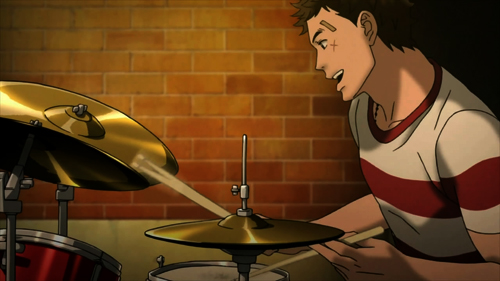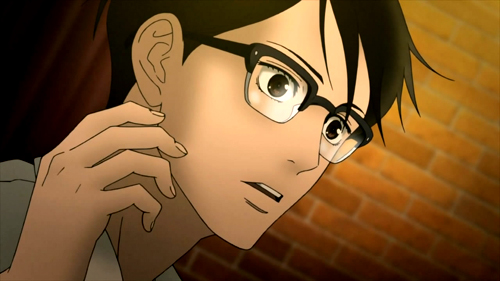Tags
Apollon, culture, Drums, emotion, Jazz, Kaoru, Kaoru Nishimi, Music, Piano, Plasticity of Music, Ritsuko, Ritsuko Mukae, Sakamichi no Apollon, Sentarou, Sentarou Kawabuchi, Universality of Music
My most awaited anime of the season finally came out. Sakamichi no Apollon features a simple yet thoughtful approach to Jazz music, making it easy for anyone to enjoy the genre. Moreover, I really love how it highlights the difference between just making sound from playing music.
There wasn’t any swing!
If you play it without feelin’ it,
it doesn’t sound like no jazz to me!
Aside from the yaoi vibes, it’s so interesting how Sentarou accused Kaoru of having no feelings as he played Art Barkley’s Moanin’. But for arguments sake let’s just agree with Sentarou, since most likely every artist would also say that music is composed of emotion and soul rather than just mere sound and silence. In fact, this idea is what I find fascinating with this art. I’m intrigued by how a listener can claim whether the performer is or isn’t playing the music with any swing.
Several believed that the artist’s feelings are transmitted to the musical instruments then gets resonated to the music. By having that swag and expressions, the performer musically and emotionally arouses the listeners. Further, it was said that major and minor scales have inherent emotional associations because their sound spectra are close to happy and sad speeches. The tempo can also be seen as an emotional indication; say for instance upbeat music is being used to signify excitement and downbeat for mellow feeling.
Hence for some, music is a common language which exists in all cultures and communicates the emotional intent of the performer.
On the other hand, some deemed that music is plastic and amplifies a wide variety of emotional states or sometimes none at all. Music doesn’t essentially rely on the artist’s style but rather on how the listener perceives the sounds. For example, the performer might be in sorrow as he plays his slow beat tempo but it’s possible that the listener hears a happy tune out from it because of how the sound is being reminiscent of some blissful memories.
It’s also likely that certain music from a specific culture isn’t considered as music in different societies but rather just a mere sound. Thus in this case, music communicates through individuation of musical expressions of emotion.
As we have seen, Kaoru initially thought that Sentarou was just blasting some odd noise but then eventually got captivated by the drummer’s beat and tempo. In this scenario, it’s not really about hearing Jazz what moved him but rather seeing Sentarou’s passion—having that swing and swag.
Evidently, there’s a connection between Sentarou’s music and Kaoru’s emotional arousal. However, I’d like to think of this not as a direct communication between the performer and the listener but a culmination of the make-believe language—as Santaro burst, it’s all about the swing that turns a sound into Jazz.
Hence, a listener can only appreciate a work only if he exercises his own mastery of the rules of make-believe. These map the audible features of music onto the imagined ideas about the experience of emotions. But before this happens, the artist must be able to unleash a certain personality into his music to move the listener.
Also come to think of it, it’s literally impossible for a piece of music to personify emotions for it is not a living body. That’s why when playing Jazz, remember, it’s all about performing the whimsical *swing* that adds factor to the music.












This article is soooooooo you :) I had a hunch you’d write about it. I also have a premonition you’re going to write more posts about it in the future… let us see.
Music is another kind of text, since it carries a ‘message’, so it’s only natural that it can be interpreted in many ways by different listeners.
Pros really can tell the difference between excellence in technique and the emotion put into the piece – I wish I could distinguish it, too.
I guess you totally know my voice already. >///<
The first episode didn't disappoint me that's I’m definitely going to keep this how. However, I'm not sure if I can blog this as much as what I did in Chihayafuru. If I managed to find something to say, I will surely write a post.
Anyway, yes music is another text. But unlike art and dialects, it's easy to come-up with one consensus when looking at these medium. For instance, "a man on a horse" truly pictures a man and a horse if everyone would agree. However, when it comes to music it's more abstract especially for us humans who highly depends on what we see. For instance, a mellow tone for me can cause joy but sorrow for others.
Pros really can tell the difference between excellence in technique and the emotion put into the piece – I wish I could distinguish it, too.
I guess each of us have our own unique spectacles. You sure do spotted some interesting things that I and others never thought of so I believe that’s something you should be proud of. ^^
“You sure do spotted some interesting things that I and others never thought of so I believe that’s something you should be proud of. ^^”
Thanks so very much for the good words. Do you have sth particular in mind?
The fact that you’re blogging (before me) and you even wrote a guest say a lot of things, right? ^^
Blogging before you was coincidental. Plus the two first years of the blog feel somehow disoriented to me :/ As for the guest, you’ve written one two. If I’m proud of anything, is that this year things started to move and that was thanks to your inspiration and advice :)
The yaoi vibes almost got to me. I hope they remain just vibes, lol
But yeah, I too liked what Sentarou said about not having that “swing” in Kaoru’s playing. I take it as having that extra human element when playing an instrument. A person can play a piece as flawless as possible, and have it rehearsed a dozen times over to leave no room for error and it’ll sound masterful. But it’ll also sound “machine” like, in that, there’s no more meaning behind what that person is playing, other than performing a piece that he knows like the back of his hand for the nth time.
Sentarou’s jazz beats was probably just him enjoying the music as he was playing it. It didn’t matter whether he was sticking to the piece or not, and seeing a person in all that jazz would just fall speechless in awe (it’s the vibes!)
extra human element
Nice one!
Indeed and totally agree. I also think that “swing” is like a signature or special touch that makes playing so unique. Or, kind of like the *X-factor*.
The drum scene was excellent!
I can somewhat identify with Kaoru as I used to play classical piano for quite some time (I still do sometimes). A decent interpretation of a classical piece involves some emotion, as well, but I indeed sometimes missed the swing and more direct emotional involvement of a jazz piece.
Music with a swing can also be somewhat stressful for the listener, though, as she/ he is confronted with the interpreter’s emotions. As a contrast, I pretty much like Miku who is constantly in a good mood without any surprises. Listening to her cute and artificial sounding voice calms me and cheers me up.
“classical piece involves some emotion”
Before I was just accepting this phrase as it is and until now I still believe it. However, the more I think of it, the more I’m being curious. How can a listener confirm that the performer is actually playing with emotions. Or, maybe the listener is just being stirred by his own emotions which he got the idea from an experience? As you said, the listener interprets what he hears. If that’s the case then, it’s not necessary to play with emotions to move somebody, especially if it’s not a live play.
Btw, thanks for the insight and I apologize if my response is quite a bit off.
I think the critical scene in this episode really captures what makes music effective. It has to have the ability to draw out the emotions that the listener wants to feel. The drums he heard very much complimented the scene on the rooftop earlier. At first he was bothered by the commotion Sentarou was making, but it in fact allowed him to forget that he stood out from his peers. He could lose himself in the moment and it was fantastic.
The drums he heard very much complimented the scene on the rooftop earlier.
I didn’t notice this until you pointed out. I guess this just simply shows how diverse a music can be. It’s common language but interpreted in so many ways.
Btw, it’s your first time visiting here. Thanks for dropping by.
Gosh, it’s something that so easy to say/ feel, but not so easy to do. Just how does one play (the same piece of music/ sing the same song) with personality? In short, I don’t know. However, I really enjoyed the sheer exuberance and passion of that moment, and the conviction, as well as skill, with which both pieces were played. Defo looking forward to seeing more from this show!
Just how does one play (the same piece of music/ sing the same song) with personality?
I also don’t know. ^^ But I guess it complements our energy. If we’re happy, we’re high and excited. If we’re sad, we’re low and unenthusiastic. And, it affects the way we play the instruments. However, having that swing is still something elusive for me in terms of how it happens.
Well, “swing” actually refers to a specific musical technique in which two eighth notes are played as one dotted eighth note and one sixteenth note. This whimsical syncopation forms the basis of Jazz music and it’s much of what gives jazz its soul. I’m not saying that “swing” doesn’t also refer to a more abstract ideal of musicianship, but I’m just pointing out that it also refers to a very specific and defined rhythm pattern.
Oic, I didn’t know that. Thanks for the insight.
More than the yaoi vibes, I really liked the focus on music in this anime, as the music is more than music. The music in this anime is used more as an exposition to great effect, be it Sentarou’s character, Kaoru’s shyness or the over-all feel of the anime.
Great post!
Thanks. I, too, really am enjoying the cool vibe and neat aspects of this show. I’m glad you enjoyed my post.